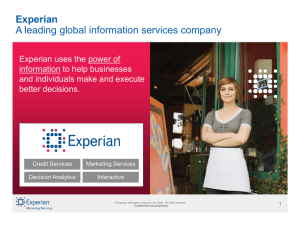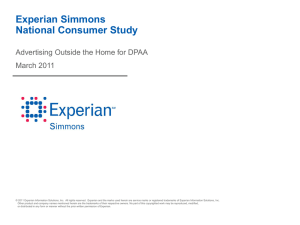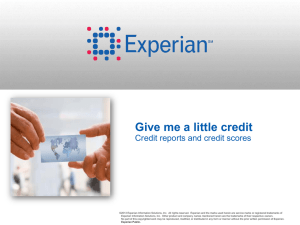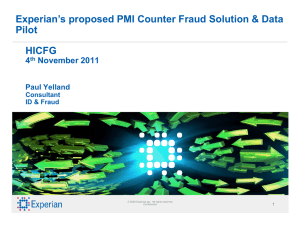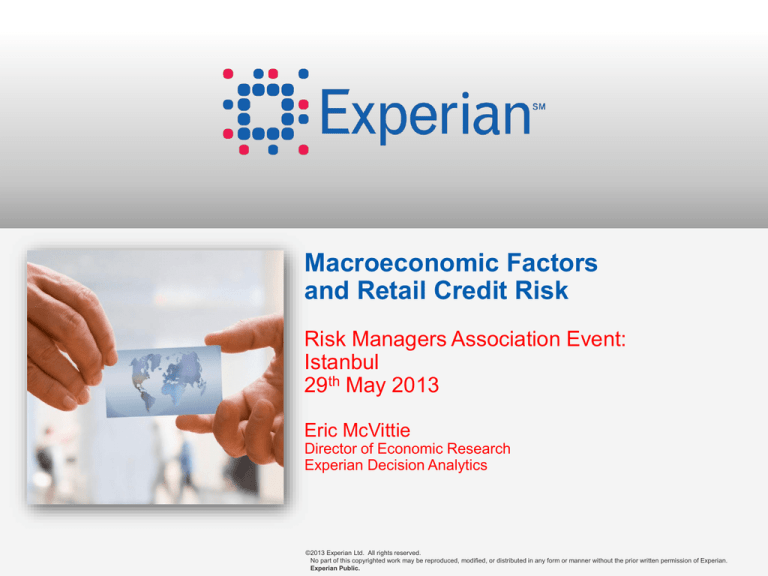
Macroeconomic Factors
and Retail Credit Risk
Risk Managers Association Event:
Istanbul
29th May 2013
Eric McVittie
Director of Economic Research
Experian Decision Analytics
©2013 Experian Ltd. All rights reserved.
No part of this copyrighted work may be reproduced, modified, or distributed in any form or manner without the prior written permission of Experian.
Experian Public.
Macroeconomic factors & retail credit risk
Agenda
Economic conditions are fundamentally important to
retail credit risk.
Increased economic uncertainty makes it increasingly
vital that lenders understand their exposures:
●
●
●
●
●
Loss Forecasting Provisioning
Concentration Risk
Risk Appetite
Scenario Analysis & Stress Testing
Acquisitions / Account Management / Collections
This is very challenging for data, models and
processes.
Important
Difficult
Possible (with care)
Effective approaches:
►
►
►
►
Maximise information extracted from available data
Take proper account of economic and non-economic
influences on loan performance
Are robust, transparent and flexible
Become integrated into lenders’ normal business
practice
©2013 Experian
Experian Information
Ltd. All rights
reserved.
©2012
Solutions,
Inc. All rights reserved.
ExperianPublic.
Public
Experian
2
Macroeconomic factors & retail credit risk
It’s Important: Value added to lenders
Combining information from conventional credit risk data and models with economic data
and models improves loss forecasting and helps optimise capital planning and allocation.
Economic models provide a robust basis for stress testing and for enhancing decision
processes within a rapidly evolving economic environment.
Risk Scores
& Portfolio
Insight
Loss Forecasting
Provisioning
Concentration Risk
Risk Appetite
Scenario Analysis &
Stress Testing
Economic
forecasting
©2013 Experian
Experian Information
Ltd. All rights
reserved.
©2012
Solutions,
Inc. All rights reserved.
ExperianPublic.
Public
Experian
Build economics
into decisions
Provisioning
/ Capital
Requirement
Risk
Committee /
Regulators
Operations
3
Macroeconomic factors & retail credit risk
It’s Important: Economic challenges persist
©2013 Experian
Experian Information
Ltd. All rights
reserved.
©2012
Solutions,
Inc. All rights reserved.
ExperianPublic.
Public
Experian
4
Macroeconomic factors & retail credit risk
It’s Important: Economic challenges persist
GDP growth forecasts for the Eurozone, Spring forecast for following year
©2013 Experian
Experian Information
Ltd. All rights
reserved.
©2012
Solutions,
Inc. All rights reserved.
ExperianPublic.
Public
Experian
5
Macroeconomic factors & retail credit risk
It’s Important: Economic challenges persist
GDP Growth Forecasts for the Turkey, Spring forecast for following year
©2013 Experian
Experian Information
Ltd. All rights
reserved.
©2012
Solutions,
Inc. All rights reserved.
ExperianPublic.
Public
Experian
6
Macroeconomic factors & retail credit risk
It’s Difficult: Requirements & challenges
• Separate economic & non-economic
factors
1
Data on
trends
/
• Identify
correct economic drivers
2
patterns in
loan • Build robust & stable models for
performance
forecasting and stress testing
3
4
• Establish forecast & stress scenario
assumptions for economic factors
5
• Loss forecasts / stressed losses / adjusted
scores / etc.
Challenges
Limited data
Many potentially relevant non-economic & economic drivers
Uncertainty over model & forecast / scenario assumptions
©2013 Experian
Experian Information
Ltd. All rights
reserved.
©2012
Solutions,
Inc. All rights reserved.
ExperianPublic.
Public
Experian
7
Macroeconomic factors & retail credit risk
It’s Difficult: The Problem
‘True’ Pr(good):
Pijt Fj yit 1, Sit , X ijt
where
Pijt = probability of good (1-PD) for individual i in population j at time t
Yit-1 = observable credit history for i up to t-1
Sit = (generally unobservable) individual ‘situational’ factors influencing i at t
Xijt = economic conditions influencing i in population j at t
Note: In general S and X vary by borrower, may include lags, and F may include
interaction terms
‘Standard’ Credit Scorecard:
Pijt G j yit 1 ijt
e.g. Logistic regression
Pijt
T
Pijt
,
ln
yit 1
0
T yit 1
1 e
1 Pijt
e
T yit 1
Standard credit risk models are backward looking, and may be subject to
biases and drifts in calibration due to changes in missing ‘situational’ factors
which influence loan performance.
©2013 Experian
Experian Information
Ltd. All rights
reserved.
©2012
Solutions,
Inc. All rights reserved.
ExperianPublic.
Public
Experian
8
Macroeconomic factors & retail credit risk
It’s Difficult: Possible Solutions
A range of approaches have been attempted to incorporate economic factors in retail credit risk models.
Aggregated models using macroeconomic factors are simple, but aggregation may lose much valuable
information. Disaggregated approaches maximize information content of available data, and allows
flexibility in selecting appropriate economic metrics, controlling for changes to lender and borrower
behaviours, and allowing for interaction between economic & non-economic determinants of default.
©2013 Experian
Experian Information
Ltd. All rights
reserved.
©2012
Solutions,
Inc. All rights reserved.
ExperianPublic.
Public
Experian
9
Macroeconomic factors & retail credit risk
It’s Difficult: Selection of economic risk factors
Rich supply of historical economic data from
official national and international sources:
►
Primary data source (for Europe: Eurostat,
national statistical offices) and statistics from
secondary agencies (e.g. OECD, IMF,
Bloomberg, Dow Jones)
Model selection criteria:
Estimation diagnostics
In-sample fit
The choice of economic factors should consider:
►
►
►
►
Do accurate historical data exist, and are there
credible forecasts of the economic data available to
generate forward-looking scores?
Is there a robust theoretical and empirical justification
for including these factors as drivers of retail credit risk
Predictive performance in holdout and ‘out of time’ samples
Simulation/forecast properties
Economic factors should directly relate to the ability to
pay. These will be factors related to income,
employment / unemployment and cost of repayment
(i.e. interest rates – even this one is perhaps
controversial)
Care is required in model specification to capture as
broad as possible a range of economic risk factors
consistent with the data and while avoiding overfitting
©2013 Experian
Experian Information
Ltd. All rights
reserved.
©2012
Solutions,
Inc. All rights reserved.
ExperianPublic.
Public
Experian
10
Macroeconomic factors & retail credit risk
It’s Difficult: Selection of economic risk factors
Search space is enormous :
►
Many potentially-relevant variables
►
Functional forms?
►
Lag structures?
Finding ‘correct’ models hampered by:
►
►
Data availability – particularly historical
time series
Estimation/Identification issues –
collinearity, endogeneity
High risk of building models based on spurious
correlations.
Grid Search / Data
Mining
Statistical Data Reduction
Methods
Theory, priors & ‘expert’
judgement
Macroeconomic factors proxy
more direct influences on
borrowers – proxy quality varies.
Restrict search space to variables
with ‘clear’ link to borrower finances:
income / net worth / affordability
Need to make efficient use of available data, avoiding excessive aggregation and
exploiting variation across sub-populations. Great care is needed to establish
robust / stable models that can generate reliable forecasts
©2013 Experian
Experian Information
Ltd. All rights
reserved.
©2012
Solutions,
Inc. All rights reserved.
ExperianPublic.
Public
Experian
11
Macroeconomic factors & retail credit risk
Example: UK Credit Card Delinquency & Unemployment
Normalized series - levels
3
Covariance Analysis
Card
Delinquency
Rate
2
ILO Unemployment Rate
Covariance
Correlation
t-Statistic
Probability
Claimant Rate
Covariance
Correlation
t-Statistic
Probability
1
0
-1
-0.375
-0.242
-2.298
0.024
-0.808
-0.400
-4.020
0.000
-2
1992
1994
1996
1998
2000
2002
2004
2006
2008
2010
Credit Card Delinquency Rate
ILO Unemployment Rate
Claimant Unemployment Rate
©2013 Experian
Experian Information
Ltd. All rights
reserved.
©2012
Solutions,
Inc. All rights reserved.
ExperianPublic.
Public
Experian
12
Macroeconomic factors & retail credit risk
Example: UK Credit Card Delinquency & Unemployment
Moving correlations between ILO rate & card delinquency rate
Moving Correlation Coefficient
1
Full Sample
Card
Delinquency
Rate
0.5
0
5 year
7 year
10 year
-0.5
15 year
-1
-1.5
1997Q1
2000Q1
2003Q1
2006Q1
ILO Unemployment Rate
Covariance
Correlation
t-Statistic
Probability
Claimant Rate
Covariance
Correlation
t-Statistic
Probability
-0.375
-0.242
-2.298
0.024
-0.808
-0.400
-4.020
0.000
2009Q1
End of rolling sample period
©2013 Experian
Experian Information
Ltd. All rights
reserved.
©2012
Solutions,
Inc. All rights reserved.
ExperianPublic.
Public
Experian
13
Macroeconomic factors & retail credit risk
Example: UK Credit Card Delinquency & Unemployment
4
Normalized series – delinquency rate levels, quarterly
changes in unemployment rates (smoothed)
Covariance Analysis
3
Card
Delinquency
Rate
2
Quarterly Change: ILO Rate
Covariance
Correlation
t-Statistic
Probability
Quarterlly Change: Claimant Rate
Covariance
Correlation
t-Statistic
Probability
1
0
-1
-2
0.136
0.755
10.545
0.000
0.145
0.676
8.417
0.000
-3
1992
1994
1996
1998
2000
2002
2004
2006
2008
2010
Credit Card Delinquency Rate
Quarterly Change in ILO Rate (Smoothed)
Quarterly Change in Claimant Rate (Smoothed)
©2013 Experian
Experian Information
Ltd. All rights
reserved.
©2012
Solutions,
Inc. All rights reserved.
ExperianPublic.
Public
Experian
14
Macroeconomic factors & retail credit risk
Example: UK Credit Card Delinquency & Unemployment
Moving correlations between quarterly changes in ILO rate & card delinquency rate
Full Sample
1
Moving Correlation Coefficient
0.8
0.6
5 year
0.4
7 year
10 year
0.2
15 year
Card
Delinquency
Rate
Quarterly Change: ILO Rate
Covariance
Correlation
t-Statistic
Probability
Quarterlly Change: Claimant Rate
Covariance
Correlation
t-Statistic
Probability
0.136
0.755
10.545
0.000
0.145
0.676
8.417
0.000
0
-0.2
1997Q1
2000Q1
2003Q1
2006Q1
2009Q1
End of rolling sample period
©2013 Experian
Experian Information
Ltd. All rights
reserved.
©2012
Solutions,
Inc. All rights reserved.
ExperianPublic.
Public
Experian
15
Macroeconomic factors & retail credit risk
Example: UK Credit Card Delinquency & Unemployment
Moving regression coefficients between changes in ILO rate & card delinquency rate
3
Moving Regression Coefficient
2.5
2
Full Sample
1.5
5 year
1
7 year
0.5
Coefficient
Std. Error
t-Statistic
Prob.
2.737
0.359
7.621
0.000
10 year
0
-0.5
-1
1997Q1
2000Q1
2003Q1
2006Q1
2009Q1
End of rolling sample period
©2013 Experian
Experian Information
Ltd. All rights
reserved.
©2012
Solutions,
Inc. All rights reserved.
ExperianPublic.
Public
Experian
16
Macroeconomic factors & retail credit risk
Example: UK Credit Card Delinquency & Unemployment
Predictive accuracy for model estimated on alternative 10 year sub-samples
Forecast Error for CCD Delinq Rate
1
0.5
0
-0.5
2009
2010
-1
2011
-1.5
-2
all
2001 2002 2003 2004 2005 2006 2007 2008 2009 2010 2011
Model estimated on 10 year sample ending:
©2013 Experian
Experian Information
Ltd. All rights
reserved.
©2012
Solutions,
Inc. All rights reserved.
ExperianPublic.
Public
Experian
17
Macroeconomic factors & retail credit risk
It’s Difficult
Some conclusions on aggregate analysis:
►
►
Estimated relationships between credit outcomes and macroeconomic factors vary
greatly depending on the estimation sample
In practice, estimating models linking short time series of historical credit data to
macroeconomic factors is highly likely to establish spurious / over-estimated
relationships to particular economic variables.
Similar results in other applications using macroeconomic data:
►
Loss models fitted on aggregated or account-level lender data
►
Argues against explanations based on model specification
►
Problem is (partially) mitigated in models using disaggregated economic data – e.g.
unemployment by local area or by age
To identify robust economic models for forecasting and stress testing need to
maximise information extracted from available data – avoiding unnecessary
and wasteful aggregation of credit or economic data
©2013 Experian
Experian Information
Ltd. All rights
reserved.
©2012
Solutions,
Inc. All rights reserved.
ExperianPublic.
Public
Experian
18
Macroeconomic factors & retail credit risk
It’s Possible: Disaggregated Models
‘True’ Pr(good):
Pijt Fj yit 1, Sit , X ijt
where
Pijt = probability of good (1-PD) for individual i in population j at time t
Yit-1 = observable credit history for i up to t-1
Sit = (generally unobservable) individual ‘situational’ factors influencing i at t
Xijt = economic conditions influencing i in population j at t
Note: In general S and X vary by borrower, may include lags, and F may include
interaction terms
‘Augmented ’ Credit Scorecard:
Pijt G j yit 1 H j ( X ijt ) ijt
where
Gj(yit-1) = standard credit score
Hj(Xijt) = economic risk score (calibration adjustment)
Use appropriate estimation and inference methods to fit and test models, allowing for (a)
potential endogeneity between economic factors and credit score; and (b) error structure
given use of aggregated time varying economic data.
This approach provides maximum flexibility and transparency while efficiently
utilizing all available data
©2013 Experian
Experian Information
Ltd. All rights
reserved.
©2012
Solutions,
Inc. All rights reserved.
ExperianPublic.
Public
Experian
19
Macroeconomic factors & retail credit risk
It’s Possible: Maximizing use of sub-national data
Most countries publish rich economic
data in far more detail than high level
macroeconomic series – e.g. for regional
and local geographies.
This disaggregated data is potentially
more relevant to the conditions of
individual borrowers/accounts than are
macroeconomic aggregates.
Careful segmentation of accounts can
also allow models to capture the
variation in sensitivity of different
borrowers/accounts to economic
conditions.
©2013 Experian
Experian Information
Ltd. All rights
reserved.
©2012
Solutions,
Inc. All rights reserved.
ExperianPublic.
Public
Experian
www.ipa.sanayi.gov.tr
20
Macroeconomic factors & retail credit risk
Conclusions
There is a need reliably to link credit outcomes to economic conditions for loss forecasting,
stress testing (and many other operational & strategic uses)
This raises big challenges for model specification and selection of economic variables –
given limited information available for estimating models and the statistical characteristics
of candidate economic variables.
Current approaches tend to emphasize a small set of macroeconomic factors (or functions
of those factors) that correlated with historical trends in credit outcomes – but some of
those relationships appear to be unstable and/or to have broken down in more recent
history.
Similar to an early-stage epidemiological study? – we can find correlations but we need to
validate their robustness and to understand the mechanisms involved before we hang too
much on the results
Is it time to rethink this problem - focusing on identifying & understanding proximate
economic drivers of default/delinquency and firmly linking those to reliably measurable
proxies?
►
Dig deeper into the economic data.
►
Exploit variation in disaggregated data for model estimation and loss forecasting.
©2013 Experian
Experian Information
Ltd. All rights
reserved.
©2012
Solutions,
Inc. All rights reserved.
ExperianPublic.
Public
Experian
21
©2013 Experian
Experian Information
Ltd. All rights
reserved.
©2012
Solutions,
Inc. All rights reserved.
ExperianPublic.
Public
Experian
22



